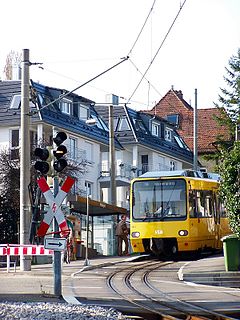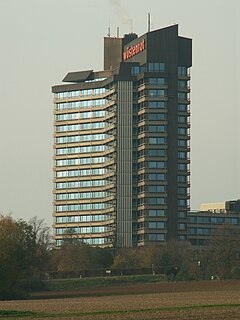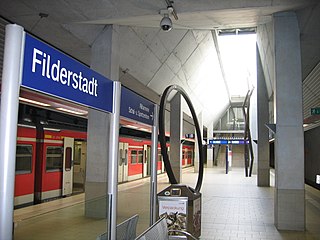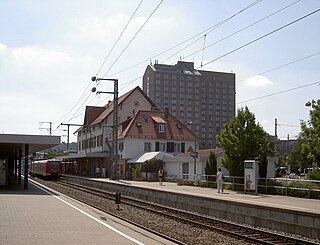
Fernsehturm Stuttgart is a 216.61 m (710.7 ft) telecommunications tower in Stuttgart, Germany. It was the first telecommunications tower in the world constructed from reinforced concrete, and it is the prototype for many such towers worldwide. Although controversial at first, it quickly became a well known landmark of Stuttgart and a tourist attraction.
Donebach is a neighborhood of the village of Mudau, Odenwald, Germany and has 369 inhabitants. At Donebach, there is the longwave transmitter of Deutschlandfunk for broadcasting on 153 kHz, whose antenna masts are with a height of 363 metres the second tallest structure of Germany.
The Mettlen–Lavorgo powerline, also called the Lukmanier powerline, is the 400 kV three-phase alternating current high voltage electric power transmission line over the Lukmanier Pass in Switzerland, from Mettlen substation, next Inwil, about 7-kilometre (4.3 mi) south of Hochdorf, to Lavorgo substation, next Lavorgo, about 5-kilometre (3.1 mi) south of Faido. Trees falling on the line in 2003 caused a major blackout in Italy.
The Transmission site Landespolizeidirektion Karlsruhe is a site with short wave aerial and an 81 metre tall telecommunication tower at 48°39′51″N8°47′42″E on the Lerchenberg near Wildberg, 20 kilometre westwards of Stuttgart. The whole area is undertunneled and equipped with an entrance which can be passed by vehicles with a height of 3.8 metres. The facility is officially used as centre for catastrophe management, but because there are no signs around it, there are many rumours about its real use.
The Directional Radio Tower Stuttgart-Möhringen is a 93-metre-high (305 ft) lattice steel tower for directional radio services of the EnBW AG on the area of the substation Stuttgart-Möhringen. The Directional Radio Tower Stuttgart-Möhringen was built in 1975 and is not accessible to the public.

The Stuttgarter Fernmeldeturm is a reinforced concrete tower for radio relay, FM, and TV transmitting services at Stuttgart-Frauenkopf in Germany. Unlike the Stuttgart TV tower, it is not accessible to the public. It belongs to Deutsche Telekom and is 192.4 metres high. The tower has an operations room with a diameter of 40.6 meters at a height of 33.78 metres.

The Killesbergpark is an urban public park of half a square kilometre in Stuttgart, Germany. It is just north of the state capital, where Killesberg is a quarter of the borough of Stuttgart-Nord (North).

The Stuttgart Rack Railway is an electric rack railway in Stuttgart, Germany. It is the only urban rack railway in Germany, and one of only four rack railways operating in Germany, along with the Bavarian Zugspitze Railway, the Drachenfels Railway and the Wendelstein Railway.

The Standseilbahn Stuttgart or Stuttgart Cable Car is a funicular railway in the city of Stuttgart, Germany. The line links the Südheimer Platz valley station with the Stuttgart Degerloch forest cemetery in the south quarters of Heslach. Operated by Stuttgarter Straßenbahnen AG (SSB), it was opened on 30 October 1929 to facilitate visitors to the forest cemetery which is located 90 metres (295 ft) above Stuttgart Heslach. At Südheimer Platz, the funicular connects to Stuttgart Stadtbahn lines U1 and U14.

The Sibelius Monument by Eila Hiltunen is dedicated to the Finnish composer Jean Sibelius (1865–1957). The monument is located at the Sibelius Park in the district of Töölö in Helsinki, the capital city of Finland.

The Wüstenrot Tower is the central office building of GdF Wüstenrot, a German building and loan association, in Ludwigsburg. It was designed by architect Prof. Ludwig Kresse in Stuttgart. The address of the 72 metres tall building is Im Tambour 1, 71630 Ludwigsburg.

The House in the Clouds is a water tower at Thorpeness, Suffolk, England. It was built in 1923 to receive water pumped from Thorpeness Windmill and was designed to improve the looks of the water tower, disguising its tank with the appearance of a weatherboarded building more in keeping with Thorpeness's mock-Tudor and Jacobean style, except seeming to float above the trees. The original capacity of the water tank was 50,000 imperial gallons (230,000 l) but during the Second World War, the House in the Clouds was hit by gunfire from anti-aircraft guns based at Thorpeness. The water tank was repaired using its own steel, which resulted in a reduced capacity of 30,000 imperial gallons (140,000 l). In 1977 the water tower was made redundant by a mains water supply to the village, and additional living space was created. In 1979 the main water tank was removed to fully convert the building into a house. The building currently has five bedrooms and three bathrooms; it contains a total of 85 steps from top to bottom and is around 70 ft high.

Stuttgarter Straßenbahnen AG (SSB) is the principal public transport operating company in the German city of Stuttgart. The SSB is a member of the Verkehrs- und Tarifverbund Stuttgart (VVS), and operates the Stuttgart Stadtbahn, bus lines, a rack railway, and a funicular railway.

Börtlingen is a municipality in the district of Göppingen in Baden-Württemberg in southern Germany.

Qalayxudat is a village in the Quba Rayon of Azerbaijan. The village forms part of the municipality of Khinalug.

Burg Krems is a castle in Styria, Austria. Burg Krems is 330 metres (1,080 ft) above sea level.
Wadi Zighen is a depression located in the Libyan Desert in the Kufra District of Libya, about 180 km north-northwest of El Tag and east of Tazirbu. There are five wells, the most important is named Bir el Hárasc. Around the wells grow some palms, but there are no permanent inhabitants.

Filderstadt station is the end point of the railway from Stuttgart-Rohr. Line S 2 of the Stuttgart S-Bahn terminates here.

Vaihingen station is located on the Gäu Railway in the German state of Baden-Württemberg. It is served by regional services and Stuttgart S-Bahn lines S1, S2 and S3. It is also a hub for public transport to the Filder plain.

As one of the most iconic and recognisable structures in the world, the Eiffel Tower, completed in 1889, has been the inspiration for the creation of over 50 similar towers around the world. Most are not exact replicas, though there are many that resemble it closely, while others look slightly different. The Eiffel Tower has also inspired other towers that are not close resembling replicas and therefore not listed here. An example of this is the Blackpool Tower on England's Irish Sea coast, one of the oldest towers inspired by Eiffel that opened in 1894, 5 years later, which proved that a tower could be a profitable tourist attraction. Not a true replica, the Blackpool tower differs from the Paris one in a number of ways: it is approximately half the height of the Eiffel, it is not freestanding as well as the fact that the base contains a row of buildings that are home to its many attractions.
















